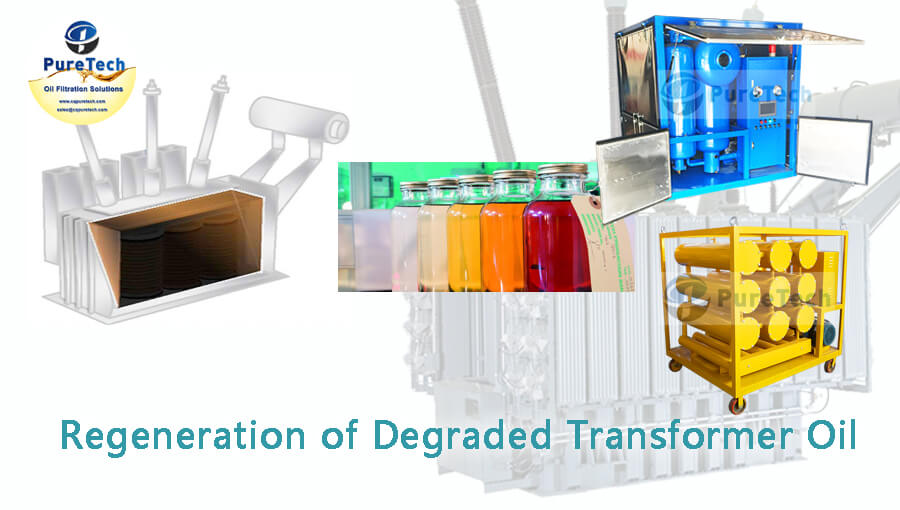What Makes Transformer Oil Regeneration an Industry Must-Have
What Makes Transformer Oil Regeneration an Industry Must-Have
Blog Article
How Regenerated Transformer Oil Extends Transformer Life Expectancy
The role of transformer oil is important in making sure the integrity and longevity of transformers, serving as both an insulator and coolant. Regrowed transformer oil provides an engaging remedy to improve these features by efficiently removing hazardous pollutants that endanger performance.
Significance of Transformer Oil
Transformer oil plays an important role in the effective operation of electric transformers. It mainly functions as an insulating tool, stopping electric discharges and making sure that elements operate securely under high voltage conditions. The oil's dielectric homes are fundamental to keeping the honesty of the transformer, as they reduce the danger of failings that can bring about devastating events or costly downtimes.
Along with its insulating capacities, transformer oil additionally works as a coolant. As transformers run, they produce warm that should be dissipated to protect against overheating and subsequent damage. The oil flows within the transformer, taking in and transferring heat away from vital parts, thereby preserving ideal operating temperature levels.
Furthermore, transformer oil works as a barrier versus moisture and impurities, which can jeopardize the efficiency and longevity of the transformer. Its chemical buildings help in counteracting acids and other results that might create over time, adding to the overall wellness of the electric system.
Benefits of Regenerated Oil

Additionally, regenerated transformer oil has a reduced level of pollutants, consisting of particles and impurities that can break down performance. This purity not just boosts the oil's thermal conductivity but additionally expands the functional lifespan of transformers by reducing overheating threats. The improved thermal security of regenerated oil ensures regular efficiency even under high operating temperature levels, which is essential for preserving transformer effectiveness.
An additional advantage is its ecological impact. Regrowed oil promotes sustainability by decreasing waste and the need for new oil manufacturing, consequently lowering the carbon footprint connected with transformer upkeep. Transformer Oil Regeneration Plant. The long life of regrowed oil translates to lower maintenance prices over time, as less oil modifications and much less regular tools downtime are called for.
Process of Oil Regeneration
The regeneration of transformer oil entails an organized process created to bring back the oil's original homes and improve its performance. This process normally begins with the removal of the made use of oil from the transformer, which is after that subjected to various filtration strategies.
The initial step in the regrowth process is the filtration, where strong pollutants such as metal, sludge, and dust particles are eliminated. This is frequently adhered to by vacuum purification, which assists to eliminate moisture and unpredictable substances, therefore enhancing the oil's dielectric stamina.

Influence On Transformer Performance
Restoring the buildings of regenerated transformer oil significantly influences the general efficiency of transformers. Enhanced dielectric toughness is among the most essential advantages, as it permits for much better insulation and minimizes the chance of electrical malfunction. This renovation results in a more steady operation under high voltage problems, eventually leading to enhanced effectiveness.
Additionally, the elimination of pollutants and destruction items throughout the regrowth process decreases the risk of getting too hot. Cleaner oil helps with much better warmth dissipation, which is essential for preserving optimum operating temperatures. Therefore, the thermal performance of the transformer is enhanced, enabling greater loads see post without jeopardizing reliability.
Moreover, the chemical stability of restored oil ensures extended operational life. It stands up to oxidation and destruction, decreasing the regularity of maintenance interventions and oil replacement. This stability not only adds to boosted efficiency yet also aligns with sustainability objectives by minimizing waste.
Future of Transformer Upkeep
As developments in modern technology remain to reshape the landscape of electrical engineering, the future of transformer maintenance is positioned for significant transformation. The combination of smart technologies, such as IoT sensors and anticipating analytics, enables real-time monitoring of transformer wellness, improving the capacity to preemptively attend to concerns prior to they rise right into major failures. This proactive method not just takes full advantage of functional efficiency however likewise prolongs the life-span of transformers.
Additionally, the application of expert system (AI) in information analysis enables for even more precise mistake discovery and diagnosis. By leveraging maker learning formulas, upkeep groups can recognize patterns in operational information that human experts may neglect, bring about more informed decision-making.
In addition, the fostering of environment-friendly techniques, consisting of making use of regenerated transformer oil, is readied to redefine maintenance methods. This sustainable method not only decreases ecological effect yet likewise enhances the general health and wellness of the transformer.
Finally, the shift towards automation in upkeep procedures is expected to improve procedures, minimize downtime, and reduced costs. As these advancements remain to progress, the future of transformer upkeep will certainly become a lot more efficient, trustworthy, and lasting, ensuring the integrity of important electrical infrastructure.
Final Thought
The use of regenerated transformer oil dramatically enhances the operational durability of transformers. By successfully bring back dielectric stamina and thermal security, this oil plays a crucial role in mitigating risks connected with getting too hot and oxidation. The regeneration process not only eliminates dangerous impurities but likewise decreases maintenance frequency and oil substitute expenses. Inevitably, the adoption of restored oil stands for a critical improvement in transformer maintenance, making certain optimal efficiency and sustainability in the management of electrical infrastructure.
The duty of transformer oil is essential in guaranteeing the integrity and durability of transformers, check serving as both an insulator and coolant.Transformer oil plays a critical duty in the reliable operation of electrical transformers. Regrowed oil advertises sustainability by decreasing waste and the need for brand-new oil manufacturing, thus reducing the carbon impact linked with transformer maintenance.Recovering the useful link residential or commercial properties of regenerated transformer oil significantly influences the total efficiency of transformers.The application of regenerated transformer oil dramatically enhances the functional long life of transformers.
Report this page